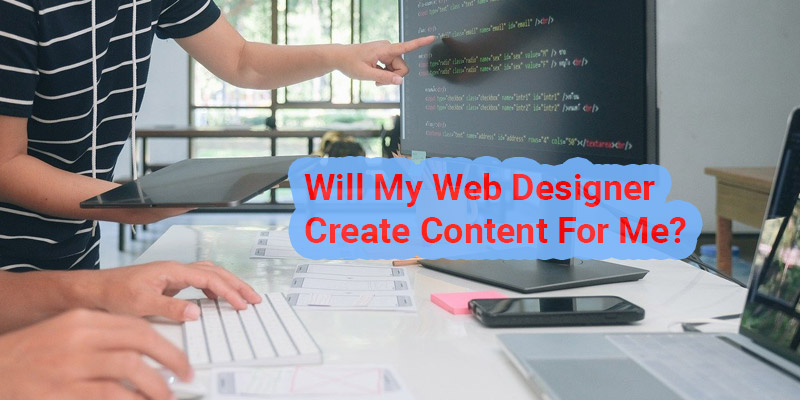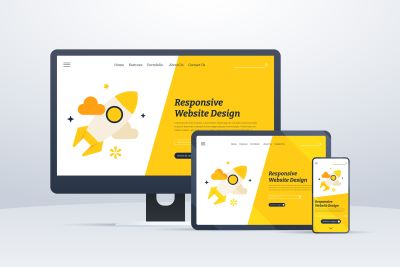
You’ve poured your heart into your business, and now it’s time to showcase it online. A stunning website is a must. You give your full focus to website design ideas, chosen the perfect layout, and finally found the web designer of your dreams.
But there’s more to it than just design. Content is king. Content creation is a vital, yet sometimes overlooked, aspect of web design. Compelling content that informs, engages, and converts visitors is crucial.
When you hire a web designer to build or redesign your website, you might wonder if they will also create the content for you. But who creates that content? This question often pops up for business owners: will their web designer handle the writing too?
What Does a Web Designer Do?
A web designer focuses on the visual aspects and layout of your website, ensuring it looks appealing and is user-friendly. Here are their main responsibilities:
Design Layout

A web designer acts like your website’s architect. Their main focus is crafting the blueprint, or layout. They decide how elements like menus, images, and text will be arranged to create a visually appealing and user-friendly experience.
This involves thinking about where users will naturally look and how to guide them through the website for a smooth and intuitive journey.
Graphics and Images
Web designers are your website’s visual storytellers. They don’t just pick random images; they carefully select or create graphics, icons, and illustrations that resonate with your brand message.
Imagine a website with cohesive visuals that perfectly capture your essence – that’s the artistic touch of a web designer. They ensure your website speaks volumes, even before a word is read.
Typography
Selecting the right fonts and text styles is essential for readability and design coherence. Web designers choose fonts that are easy to read and match the overall aesthetic of the website. They ensure the typography aligns with the site’s look and feel, enhancing the visual appeal and user experience.
Good typography makes the content accessible and engaging, guiding users through the site seamlessly. By balancing style and readability, web designers create a cohesive design that supports the website’s purpose and keeps visitors engaged.
Effective typography is not just about aesthetics; it’s about creating a pleasant and efficient reading experience that complements the overall design.
Color Schemes
A well-thought-out color scheme is crucial for creating a cohesive and attractive website. Web designers choose colors that complement each other and align with the brand’s identity. They apply color theory to develop a palette that enhances both the visual appeal and readability of the site.
By selecting harmonious colors, they ensure that the website is not only visually pleasing but also effectively communicates the brand’s message. The right color scheme can guide users’ attention, evoke emotions, and improve the overall user experience.
Thus, web designers carefully plan and implement color schemes to create a balanced and engaging website design.
User Experience (UX) Design
User experience (UX) is a crucial aspect of web design. Web designers ensure the website is easy to use and navigate, focusing on how users interact with the site. They create intuitive and user-friendly interfaces by designing wireframes and prototypes to test usability.
This process helps identify potential issues and refine the design before the final version is built. By prioritizing UX, web designers enhance user satisfaction, making the site more accessible and enjoyable to use.
Effective UX design not only improves functionality but also helps retain visitors and encourages them to explore the website further.
Tools of the Trade
To achieve all these tasks, web designers use various tools and software. Adobe Photoshop and Illustrator are popular for creating and editing graphics. Design software like Figma or Sketch is used to create mockups and prototypes. These tools allow web designers to visualize how the website will look and function before it is built.
Also Read: Things You Should Know Before Hiring a Web Designer
What is Content Creation for a Business Website?
Content creation involves producing the text, images, videos, and other media that will be displayed on your website. This content is crucial because it communicates your message to your visitors and helps with search engine optimization (SEO). Key aspects of content creation include:
- Text Content: Writing the words that will appear on your site, such as blog posts, product descriptions, and about pages.
- Visual Content: Creating images, infographics, and videos that help convey your message.
- SEO: Ensuring that your content includes relevant keywords and phrases that help your site rank higher in search engine results.
- Engagement: Crafting content that is interesting and engaging to your audience, encouraging them to stay on your site longer and interact with your brand.
Content creation is often done by specialized professionals like copywriters, content writers, photographers, and videographers.
Will My Web Designer Create Content for Me?
Now that we understand the roles of web designers and content creators, let’s address the main question: Will your web designer create content for you?
The short answer is usually no, but it depends on the specific agreement you have with your web designer. Here’s a more detailed look at why this is the case and what you can expect:
Primary Focus
As mentioned earlier, web designers primarily focus on the visual aspects and layout of your website. They are trained to make your site look appealing and ensure it’s easy to navigate. Content creation, on the other hand, requires a different skill set focused on writing and media production.
Specialized Skills
Creating high-quality content requires specialized skills. For example, writing engaging and SEO-friendly blog posts requires knowledge of writing techniques and SEO strategies. Similarly, producing professional images and videos requires photography and videography skills. Most web designers are not trained in these areas.
Time and Resources
Creating content is a time-consuming process. It involves research, writing, editing, and optimizing for SEO. If web designers were to take on this task, it would likely detract from their primary focus on design and development.
How to Manage Content Creation for Your Website
Even though your web designer might not create content for you, there are several ways you can manage content creation for your website:
- Hire a Content Writer: You can hire a professional content writer or copywriter to produce the text for your website. These professionals are skilled in writing engaging and SEO-friendly content.
- Work with a Content Creation Agency: There are agencies that specialize in content creation. They can provide a full range of services, including writing, photography, and videography.
- DIY Approach: If you have the time and skills, you can create the content yourself. This approach can save money, but it requires a significant time investment.
- Collaborate with Your Web Designer: While your web designer might not create the content, they can offer guidance on what type of content will work best with the design. They might also work with you to integrate the content seamlessly into the website.
The Essential Website Content Toolbox
A well-rounded website needs a variety of content formats to cater to different visitor preferences and effectively communicate your brand message. Here are some key tools in your content toolbox:
- Homepage: This is your digital storefront’s welcome sign. The homepage should clearly explain your business, its value proposition, and the problem you solve. Use clear, concise language, captivating visuals, and a compelling call to action (CTA) to guide visitors toward the next step.
- About Us: Tell your story! Share your company’s mission, values, and the team behind the brand. Highlighting human connections allows visitors to build trust and connect with your brand on a personal level.
- Products or Services: This is where you showcase what you offer. Provide detailed descriptions, high-quality images or videos, and highlight the benefits your product or service provides. Consider including customer testimonials to build credibility.
- Blog: A blog is a powerful tool to establish your expertise, engage visitors, and boost SEO. Create informative and valuable content related to your industry. Share industry trends, answer common questions, and offer tips or solutions relevant to your target audience.
- FAQs: An FAQ (Frequently Asked Questions) section anticipates and addresses common customer inquiries. This saves visitors time and provides easy access to essential information.
- Contact Us: Make it easy for visitors to connect with you. Include your contact details, a contact form, and a map (if you have a physical location). Consider offering a live chat option for real-time interaction.
FAQ’s
Does web design work include content editing?
Web design and content editing are often separate services. While some designers might offer basic editing or placeholder text suggestions, in-depth content creation or editing usually falls outside their scope. Designers focus on the visual layout and functionality, not necessarily the grammar or flow of your text.
Some designers might offer basic editing as part of their service, it’s usually an extra fee. For polished content, consider hiring a content editor or copywriter to collaborate with your web designer.
Why wouldn’t my web designer create the content?
Web design and content creation require different skillsets. Designers excel in visual communication and user experience, while content creators specialize in crafting engaging and informative text, videos, or other media.